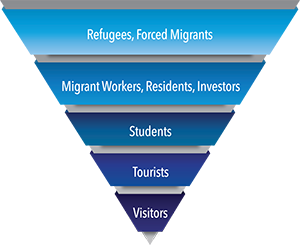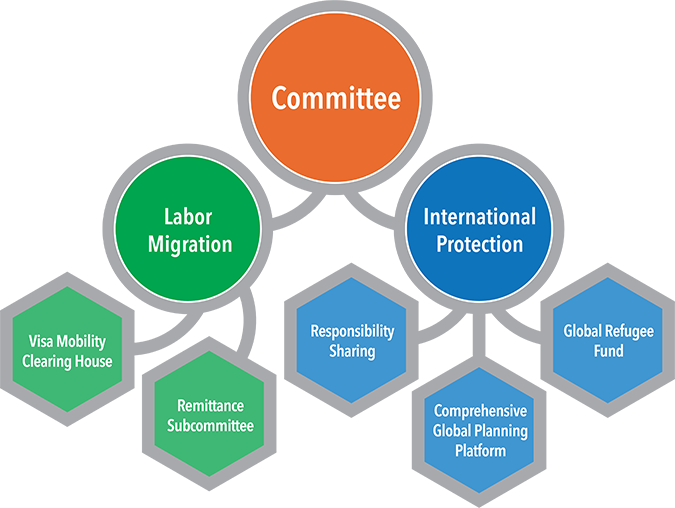The Model International Mobility Convention proposes a framework for mobility with the goals of reaffirming the existing rights afforded to mobile people (and the corresponding rights and responsibilities of states) as well as expanding those basic rights where warranted.
While people are as mobile as they ever were in our globalized world, the movement of people across borders lacks global regulation. This leaves many refugees in protracted displacement and many migrants unprotected in irregular and dire situations. Meanwhile, some states have become concerned that their borders have become irrelevant. International mobility—the movement of individuals across borders for any length of time as visitors, students, tourists, labor migrants, entrepreneurs, long-term residents, asylum seekers, or refugees—has no common definition or legal framework. To address this key gap in international law, and the growing gaps in protection and responsibility that are leaving people vulnerable, the "Model International Mobility Convention" proposes a framework for mobility with the goals of reaffirming the existing rights afforded to mobile people (and the corresponding rights and responsibilities of states) as well as expanding those basic rights where warranted.
In 213 articles divided over eight chapters, the Convention establishes both the minimum rights afforded to all people who cross state borders as visitors, and the special rights afforded to tourists, students, migrant workers, investors and residents, forced migrants, refugees, migrant victims of trafficking and migrants caught in countries in crisis. Some of these categories are covered by existing international legal regimes. However, in this Convention these groups are for the first time brought together under a single framework. With the aim to help the reader navigate through the MIMC and the rights it contains, a visualization of the rights outlined in the MIMC can be found here.

An essential feature of the Convention is that it is cumulative. This means, for the most part, that the chapters build on and add rights to the set of rights afforded to categories of migrants covered by earlier chapters. The Convention contains not only provisions that afford rights to migrants and, to a lesser extent, States (such as the right to decide who can enter and remain in their territory). It also articulates the responsibilities of migrants vis-à-vis States and the rights and responsibilities of different institutions that do not directly respond to a right held by migrants.

The Model International Mobility Convention was developed by a Commission of eminent academic and policy experts in the fields on migration, human rights, national security, labor economics and refugee law. The Commission came together to debate and develop the Convention in workshops conducted regularly from spring 2015 until it was finalized in April 2017.
The Columbia Journal of Transnational Law published the Model International Mobility Convention in a Special Issue in January of 2018, which includes commentaries by the following twelve authors.
- "The Fatal Flaw in International Law for Migration" by E. Tendayi Achiume, Assistant Professor of Law at UCLA School of Law.
- "Undocumented or Irregular Migrant Workers under the Model International Mobility Convention: Rights and Regularization" by Diego Acosta, Reader in Migration and European Law at the University of Bristol.
- "Taking Mobility Seriously in the Model International Mobility Convention" by T. Alexander Aleinikoff, Director of the Zolberg Institute on Migration and Mobility, University Professor at The New School in New York City.
- "Rethinking the Global Governance of International Protection" by Kiran Banerjee, Assistant Professor in the Department of Political Studies at the University of Saskatchewan.
- "An Overview of the Model Convention" by Emma Borgnäs, Project Coordinator for the International Migration Project at the Columbia Global Policy Initiative.
- "The Model International Mobility Convention [Introduction]" by Michael W. Doyle, Director of the Columbia Global Policy Initiative, University Professor of Columbia University.
- "Negotiating for Women's Mobility Rights: Between Definition and Contestation" by Yasmine Ergas, Director of the Specialization on Gender and Public Policy at the School of International and Public Affairs of Columbia University.
- "Labor Migration and International Mobility: Normative Principles, Political Constraints" by Randall Hansen, Director of the Munk School of Global Affairs, University of Toronto.
- "Think Mobility Instead of Migration: Leveraging Visitors, Tourists and Students for More International Cooperation" by Rey Koslowski, Associate Professor of Political Science and Director of the Master of International Affairs Program, Rockefeller College of Public Affairs and Policy, University at Albany, State University of New York (SUNY).
- "The Mobility Convention's Contribution to Addressing Socioeconomic Issues in Protracted Refugee Situations" by Sarah Deardorff Miller, Adjunct Professor at the School of International and Public Affairs of Columbia University and the School of Advanced Study, University of London.
- "Beyond Mapped Horizons: Reflections on the Model International Mobility Convention" by Parvati Nair, Founding Director of the United Nations University Institute on Globalization, Culture and Mobility (UNU-GCM), Professor of Hispanic, Cultural and Migration Studies at Queen Mary University of London, former Director of the Centre for the Study of Migration.
- "Pathways to Protection and Permanency: Towards Regulated Global Economic Migration and Mobility" by Sarah Rosengaertner, Migration and Development Expert at the Columbia Global Policy Initiative, consultant to various United Nations entities and the German development agency GIZ (Deutsche Gesellschaft für Internationale Zusammenarbeit) on migration policy and governance.